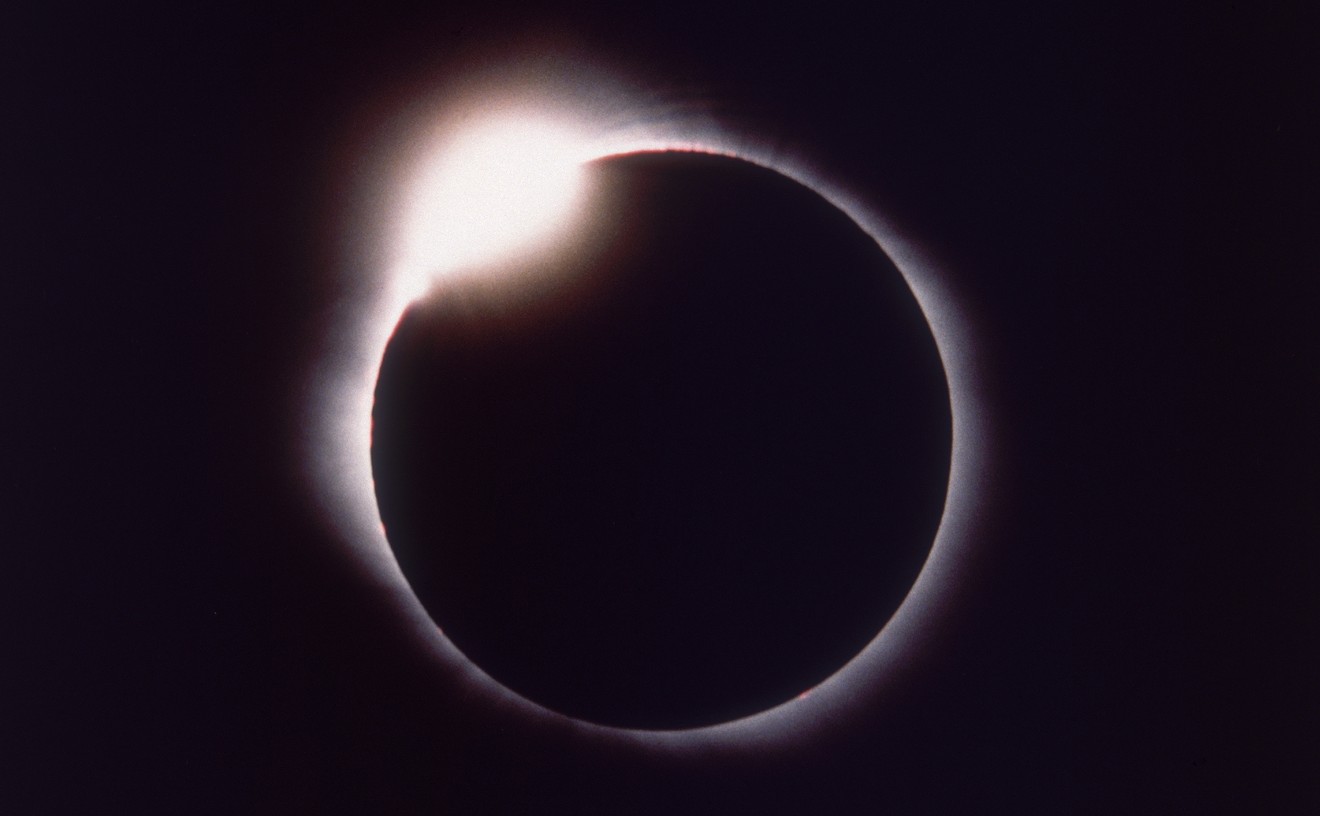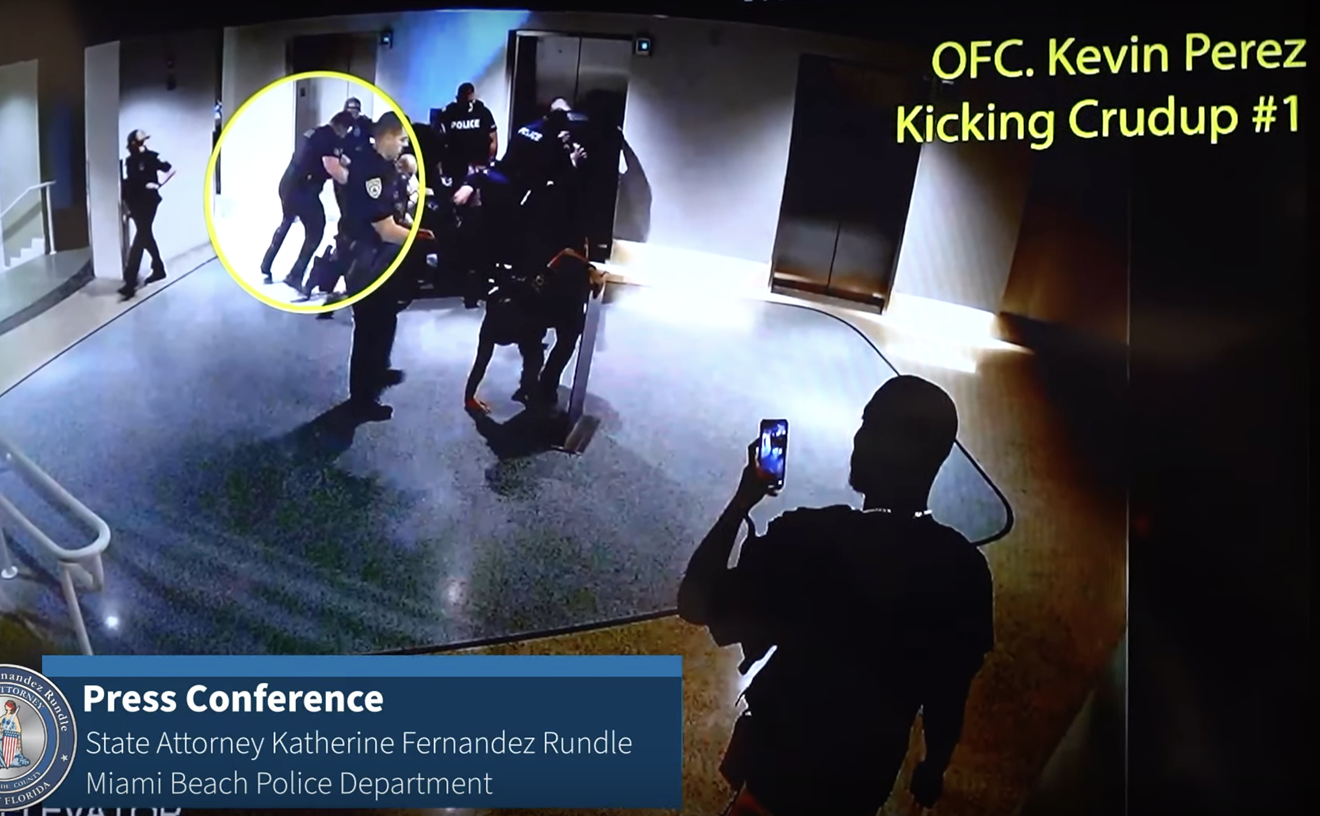"Got 'em on!" Mark "the Shark" Quartiano roars while his first mate stabs a shark with a gaff and hauls it out of the placid Atlantic Ocean. "In the boat, get him in the boat! Yeah, got 'em on!"
Thwacking its tail and flipping over so the white of its belly shows, the Atlantic sharpnose thrashes across the deck of the 46-foot Striker-1. Blood pours out of a gash near its gills, torn open by the sharp hook of the gaff.
Six guys onboard for a bachelor party take a break from sipping Bud Light to pose for pictures with the catch, which the soon-to-be-groom reeled in himself. They hold it away from their bodies so the spurting blood doesn't soak their clothes.
Then Quartiano's crew throws the shark into the live well after the captain — blond, barrel-chested, and wearing fishing bibs and a shark-tooth necklace — pries away the flip-flop it had snatched between its jaws while flailing about the boat. He's taking this catch back to the dock.
The tide has turned against Mark the Shark.
tweet this
After more than three decades in business, Quartiano has earned an international reputation for both his skill in reeling in the monsters of his customers' dreams and his bravado over killing the creatures. He is perhaps America's best-known shark angler after starring in dozens of fishing and reality TV shows and attracting a star-studded client list including Will Smith, Shaquille O'Neal, Ice-T, and Rosie O'Donnell.
But in recent years, Quartiano has become known less for headlines as a shark-conquering hero and more for accusations that he's a butcher of the seas.
As Jaws-induced hysteria has faded, Discovery Channel's Shark Week has brought conservation into American living rooms, and scientists have sounded the alarm about dwindling shark populations. Social media, meanwhile, has given an ever bigger platform to critics of big-game hunting and fishing. The tide has turned against Mark the Shark — especially because these days, most of his fellow fishermen catch and release their prey.
"We put everything back that we possibly can," says Bouncer Smith, a Miami charter captain since 1965. "One of the products of 50 years in the industry is I know how much fishing has declined."
That's not Quartiano's style. Although he says he kills just a fraction of the sharks he catches, his loud boasting about the ones he does slaughter has made him a public enemy of conservationists and a pariah in the fishing community.
Quartiano relishes his role as the bad guy. He regularly posts photos of dead sharks to his 63,000-follower Instagram account (@marktheshark) with captions like "Nothing gets away!" and "Fillet and release." His website cautions that some pictures "may not be suitable for very small children, the faint-hearted, or PETA members." Splayed across the site are shots of hammerhead, tiger, and other shark species hanging lifeless over the deck of Striker-1 while Quartiano grips their tails and grins. "I wanna go out there and catch maybe the last one," he said during one Shark Week appearance.
This kind of approach should have disappeared 20 years ago when the consequences of shark overfishing became clear, his critics say.
"In the case of animals that are not sustainable, such as some of these sharks, it is sinful to go out and kill them just for the picture or weight," says George Burgess, a fisheries biologist and shark expert at the Florida Museum of Natural History.
But Quartiano has no plans of stopping. Now in his early 60s, he's killed thousands of sharks, and every time he pulls in another, the thrill is still there. He's on the ocean almost all day, every day, including weekends, his birthday, and Christmas. His wife jokes that he doesn't know how to function on land. His customers, who fork over $1,200 for a day of fishing with him, are usually satisfied. Even his critics often acknowledge he's very good at what he does.
Quartiano mostly shrugs off suggestions that he's doing lasting damage to the ocean: The scientists are wrong, the commercial fishing industry kills far more fish, and the number he takes in is negligible — a drop in the bucket, he insists.
Yet, he notes, "there's definitely less sharks in Miami now. I'm probably responsible for that."
For hundreds of millions of years, sharks have stalked Earth's seas. They were here before dinosaurs and have now lasted twice as long. Through five mass extinctions, some species of shark has somehow survived.
Ever since humans showed up several million years ago and began venturing into the ocean, sharks have both fascinated and terrified us. Aristotle documented them. North America's earliest inhabitants relied on them for food. The U.S. government spent decades trying (unsuccessfully) to develop ways to repel them after World War II sailors rescued from sea told of shipmates snatched away in the beasts' jaws.
The first documented encounter between shark and man came shortly after Christ's death, according to a paper by Jose Castro, a biologist at the National Oceanic and Atmospheric Administration (NOAA). Pliny, a Roman writer, described violent clashes between divers and "dogfish" — so named because, like dogs, they were known to bite.
"The one safety lies in going for them and frightening them by taking the offensive; for a dog-fish is as much afraid of a man as a man is of it, and so they are on equal terms in deep water," Pliny wrote.
In the United States, commercial shark fishing has existed for 300 years, driven by demand for oil from the animal's liver — which was used as a lubricant, leather-treating solution, and source of vitamin A — and shark skin, which was tanned into leather. Shark fins also became a valuable commodity because of demand in China, where they are used in a soup that's both a delicacy and a status symbol.
In the '30s and '40s, the shark-fishing industry took off in Florida, where blacktip, hammerhead, spinner, blacknose, sandbar, nurse, and bonnethead sharks all thrive. By the '60s, boats were dropping miles-long lines deep into the ocean, snagging sharks by the hundreds. Anglers were also catching the fish for fun.
“I’d heard all about sharks, the whole mystique. All the sudden, it becomes like an obsession.”
tweet this
Many local piers banned shark fishing, fearing it would scare tourists away, recalls William Fundora, president of the South Florida Shark Fishing Club. But the old South Beach Pier did not, so shark fishermen clustered there, casting out reels and waiting.
"I think shark fishing attracted a certain hardy person: a macho-type guy that wanted to compete, outdo his friends, be the toughest, baddest guy," Fundora says.
Among them was Quartiano, who began fishing the pier as a boy in the mid-'60s. He was the first of two boys born in New York to a missionary and a World War II veteran-turned-cash-register-salesman. The boys spent their early years living in a multilevel house with their parents, their aunt and her family, and their grandmother — one big Italian family.
Quartiano had always loved fishing, even when he had to cast out in a muddy, condom-strewn canal near his Coney Island home. He pulled out eels that his grandmother would rinse in a bathtub and cook ("Italians eat everything," he quips). Mark and his brother learned to fish from their dad, Fred, a Navy man who loved the water. Every chance he got, he took his boys to cast reels in canals and piers.
"It was our calling," Tommy Quartiano says. "We picked up a fishing rod and read Ernest Hemingway stories and saw the big tunas they used to catch off the Bahamas and thought, Maybe one day, we'll catch one of those."
Once, when Quartiano was casting for flounder off Montauk with his dad, he instead hooked a thresher shark. It flopped around in the little boat, whacking him with its tail.
"I'd never seen anything like that," Quartiano recalls. "I'd heard all about sharks, the whole mystique. All the sudden, it becomes like an obsession."
After Quartiano's parents divorced, his father moved to Miami Beach. When Quartiano was about 10 years old, he traveled to Florida to stay with him. It was supposed to be only a visit, but after a week of fishing daily with kids he met at the South Beach Pier, he told his dad he wasn't leaving. And he never did.
"I didn't even go back for my clothes," he recalls. Within a few years, his brother Tommy, who is younger by two years, had joined him.
Even as a kid, Tommy Quartiano remembers, his older brother was "an instigator" who was "abusive in a fun way." He'd figure out your weakness and pick on you relentlessly. He was mischievous too. The Quartiano boys and their friends often slept on piers or bridges or beaches when fishing. Occasionally, someone would wake up smelling terrible.
"You'd look in your sleeping bag, and there's fish in there," Tommy Quartiano recalls, chuckling. "How did it get in there? We knew how it got in there, you know what I mean? There's nobody else that would do that."
Quartiano also stood out for his skills with a reel and rod. James Fuqua learned how to land sharks from fishermen in West Palm Beach and then began teaching the kids at the South Beach Pier. But the teenaged Quartiano didn't need any help. He could cast farther than anyone and routinely reeled in massive catches. He was "very flamboyant," Fuque recalls. "He would do whatever he wanted, and there was no one who could tell him what to do — even back then."
Fishing was number one in Quartiano's life. So when he had to choose a career, he was sold on the four-day workweeks offered in public safety: That way, he could fish the other three days. After graduating from Miami Beach Senior High and Miami Dade College, he became a firefighter and then a police officer patrolling the streets of downtown Miami.
On his days off, he and Tommy, who also went into law enforcement, packed their van with fishing rods and coolers and drove north or south, hitting Sebastian Inlet or the bridges in the Keys. They'd come home with coolers packed full of fish.
Everything changed in the summer of 1975. That's when Jaws hit screens and became an instant phenomenon. Millions flocked to see the story of a New England tourist town terrorized by a man-eating great white shark, earning the flick nearly $471 million, surpassing The Godfather as North America's highest-grossing film of all time.
Suddenly, all of America was as shark-obsessed as Quartiano.
"The movie Jaws resulted in what I've been fond of referring to as a collective testosterone rush up and down the East and West Coasts," says Burgess, the biologist. "Everybody wanted to have their picture taken with the big shark jaw."
And everybody wanted to catch a shark of their own. Quartiano began taking groups of three or four out fishing on a 23-foot Seacraft his dad helped him and his brother buy in 1978. Unlike working as a cop, Quartiano loved it.
Being an officer "seemed like a cool job until you were actually in it," he says. Then you had to deal with "dirtbags" on a daily basis, not to mention being hated by everyone. In 1982, Quartiano decided he didn't want to "get killed for $300 a week."
So he quit the police force and started chasing sharks full-time.
Robert De Niro lounged on the upper deck of the Striker-1 while smoking a cigar and reading a script for Analyze This. There was a tug on the line, and his assistant grabbed the rod. After fighting for 20 minutes, she finally reeled in the catch: a rubber chicken.
Quartiano and Ryan Wallach, his first mate, had a good laugh. They still tell the story today: how De Niro, a serious but "supernice guy," took it in stride. A photograph in Quartiano's office shows the famed actor steering the boat, a Corona in his hand and the captain beside him. A thank-you note is scrawled across the image.
The year was 1999, and Striker-1 was amid a parade of celebrity customers. Quartiano's rise to become one of America's most famed fishing captains had been meteoric. He had jumped into shark-hunting at exactly the right time and used his natural gifts — as a fisherman, promoter, and personality — to rise to the top.
His ascent began in the late '70s, when he won the Marathon Jaycees World Championship Shark Tournament year after year. He was the reigning champion from 1979 to 1983, beating nearly 100 other teams. During one 30-hour period, his team bagged 18 sharks weighing a total of 2,000 pounds, and Quartiano was feted as a macho hero.
“The common view was that sharks were bloodthirsty animals who wanted to cut you in half.”
tweet this
A 1984 story in the Miami Herald described the captain as a ruggedly handsome shark hunter extraordinaire."I dream about sharks," the then-31-year-old told the newspaper. "This has become a high for me, like a drug, almost."
At the time, America was still in the clutches of its Jaws craze thanks to the release of second, third, and fourth installments. Charter companies hung up sharks at their docks as a form of advertising. Local taxidermy companies sent three or four trucks to marinas each day to pick up all the shark carcasses. And shark-fishing tournaments like the one in the Keys sprung up across the nation.
Few people objected to all the shark killing in those days. Scientists often monitored or even sponsored tournaments so they could collect the dead sharks for studies. At the time, many researchers believed the ocean was boundless, Burgess says. As for the general public, most were flat-out terrified of sharks.
"The common view was that sharks were bloodthirsty animals who wanted to cut you in half," Fundora says.
So it's no shock that local media chronicled Quartiano's exploits with gusto. His catches made the papers and the TV news, and customers flocked in.
Soon he decided he needed a bigger boat. He traded in his 23-foot Seacraft for a 27-foot Aquasport customized for monster fishing. The new Striker-1 had enough power to fight a 2,000-pound tiger shark, Quartiano told the Sun Sentinel in 1985. The boat featured a special trapdoor for hauling in big fish and a fighting chair that had an etching of a hammerhead shark for a footrest.
Charter fishing was big business for Miami in those days, before, as Quartiano puts it, "South Beach became South Beach." Quartiano often had two trips a day. If clients didn't land their trophy fish, they got their money back — but it wasn't uncommon to catch several sharks in one trip.
Herald funnyman Dave Barry accompanied Quartiano to a shark-fishing tournament in 1989. "For most of us," Barry noted in his nationally syndicated column, "our natural reaction to a shark is to want to shoot it with the largest available bazooka." The shark fishermen were a brawny, "extremely masculine" set, he wrote. With Barry watching from the "cowering journalist deck," Quartiano hauled in a "10-foot, 315-pound, fairly annoyed shark."
Even as he rose to fame, though, Quartiano's personal life was tumultuous. The fisherman acknowledges that working constantly wasn't good for his relationships. Miami-Dade County court records show he was married four times between 1978 and 1993. "When you're working every day, it's hard on everybody," Quartiano says.
His rise also didn't come without ruffling official feathers. In 1995, a swarm of officers descended upon Quartiano's dock and arrested him. The crime: selling six sailfish to an undercover agent. Florida's official saltwater fish had been federally protected for years because of its declining numbers worldwide. After pleading no contest to the illegal sale and possessing more than the legal limit of one sailfish, he paid thousands of dollars in fines.
"It was a total entrapment case," Quartiano says. "It's like, 'Hello, it's a sailfish. I didn't murder anybody.'?"
When the Herald published a story about the bust, he told his dad he worried he would go out of business.
"He said, 'Are you crazy? Do you know what it would cost for that ad?'?" he recalls now. "And he was 100 percent right." After his arrest, the phone rang off the hook with people who wanted to land sailfish.
In the '90s and early '00s, all kinds of media outlets made the trip down to Miami to film segments about Mark the Shark. He hosted crews from Shark Week, Inside Edition, ESPN, CNN Headline News, and NBC Nightly News. "As Seen on Natl. T.V.," Quartiano added to the sign above his dock at the Biscayne Bay Marriott Marina.
The cast of MTV's Real World fished with him in 1996, when the show spent a season in Miami Beach. "We had people on the boat getting sick, I was yelling at them, we were catching one dolphin after the next," Quartiano recalls.
He was hired for charters by Clint Eastwood, former Chicago Bears linebacker Dick Butkus, and Aerosmith drummer Joey Kramer, among others. Quartiano is full of stories from those trips: Will and Jada Pinkett Smith didn't fish — they simply wanted to hang out on the boat. Robin Williams was "like somebody on cocaine, a thousand miles per hour."
Billy Strudwick, a former charter captain, says others in the industry were jealous of Mark the Shark's success. But Strudwick had always gotten along with Quartiano and was happy for him: He was a skilled fisherman and a hard worker.
"I had an obsession when I was growing up to do this," Quartiano says. "And I wouldn't want to be number two. I always wanted to be number one, or else I wouldn't have done it."
The photo landed in email inboxes and fax machines at TV stations and newspapers around Miami in 2005: Mark the Shark, smiling, sprawled atop a pile of four dead sharks. With one hand, he held open a jaw; with the other, he gripped a fin. A press release trumpeted the "First ever grand slam of killer sharks caught off Miami Beach by Mark the Shark!"
This time, few were impressed. One of the slain sharks was a bigeye thresher, a federally protected animal. Catching it was illegal in federal waters.
Quartiano claimed he reeled the fish in two miles off the coast of Miami Beach, in state waters. But because the thresher is a deep-water shark, experts weren't convinced. "Quartiano's insatiable greed and ego are far, far scarier than the sharks he stalks," New Times wrote. Weeks later, a front-page Herald story questioned whether Mark the Shark was "a hero or a butcher."
“I hope one of these majestic animals rips you from your... boat and tears you... apart piece by piece.”
tweet this
The moment marked a sea change for a fisherman who had grown used to glowing headlines, but the criticism had been building for years while scientists showed that sharks were dwindling from overfishing. Today, Mark the Shark is assailed by critics who bombard his Instagram and Facebook pages and occasionally wish death upon him. One online petition with 845 signatures calls for his fishing license to be revoked.
"Mark Quartiano, I hope you meet your fucking end," one enemy, his face inches from the camera, screams on a YouTube video. "And I hope one of these majestic animals rips you from your fucking boat and tears you fucking apart piece by piece, making you live the whole experience a billion times over in fucking hell."
For the most part, Quartiano is unfazed — even entertained — by the outrage. Bring it on, he says: If it gets his name out there, it's good for business.
But some other local fishermen shake their heads at his refusal to change.
"Mark has built a huge business on controversy, and it baffles me that such a good fisherman has to use such bad practices to build his business," says Smith, the Miami charter captain. (Quartiano hits back and says Smith has no room to criticize his tactics because Smith kills sailfish and swordfish for his customers.)
For decades, scientists have been raising concerns about declining shark populations. By the early '90s, research was painting a bleak picture: Eighty to 90 percent of the dusky and sandbar population was gone, according to Burgess. Others, including hammerheads, were also in trouble. Many types of sharks take years to mature and produce fewer young less frequently than other fish. So they were particularly vulnerable to overfishing, and recovering their numbers would take decades, not years.
"These things are basically poster children for the decline of the ocean," Burgess says.
The first shark fisheries management plan was drafted in 1992 by NOAA, limiting catches. Other regulations followed, at both the state and federal levels.
Many tournaments changed their rules, ordering competitors to release the sharks. The South Florida Shark Club stopped weighing catches in favor of snapping photographs and letting them go. Fuqua, who fished for sharks with Quartiano as a teenager, says today he would "never kill a beautiful animal like a shark."
"Back then, I'm going to tell you, we were ruthless," he says. "If I look back now, it was terrible. I wouldn't want no one to know. To tell you the truth, I'm embarrassed."
In the general public too, attitudes have shifted rapidly. Shark-fishing tournaments, despite their catch-and-release rules, began drawing protesters. In 2012, when photos spread of Rosie O'Donnell and her children smiling in front of a hammerhead she killed with Mark the Shark, a global outcry erupted.
But as views on the animals evolved, Mark the Shark remained stubbornly the same. His customers pay good money, so if they want to take a shark home, so be it. He'll make sure they walk away happy.
"The customer is paying a lot of money. He doesn't want a story; he wants a memory," Quartiano says.
But he's also resistant to the research that's driven the changing views. He doesn't believe sharks like hammerheads or sandbars are actually endangered. "That's all bullshit," he insists. "Sharks are not endangered. I catch them every day."
Quartiano isn't without allies, including some scientists who take sharks from him for research. Jose Castro, the NOAA biologist, confirms Quartiano has given him specimens.
"He's helped me with animals that I needed because I couldn't get them any other way," Castro says. As a scientist, he doesn't think Quartiano's small-scale shark-fishing has any real impact on the population."If somebody wants to make noise about it," he says of the fisherman's critics, "let them."
Other researchers aren't as accepting, though. Neil Hammerschlag, director of the Shark Research and Conservation Program at the University of Miami, says in a 2011 book called Demon Fish that he considered rallying activists to picket near Quartiano's dock. Ultimately, he decided against it, believing it would give Quartiano only more motivation to "live up to the legend he's trying to create for himself."
"That kind of fishing... is a dinosaur in the recreational field," says Burgess, "and does not adhere to our current thought processes involving conservation in sportfishing."
Any arguments with the scientific community, though, pale in comparison to Quartiano's battles on social media. On Instagram, he's fond of egging his critics on with captions and hashtags like "PETA this" and "YEA WE KILL SHARKS."
"He's playing a part," his brother says. "Part is acted; part is genuine. You have to learn to figure out which is which."
Strudwick says he has tried to tell Quartiano to tone it down with the Instagram pictures. At least wipe the blood off the deck, he says. People aren't into that kind of thing anymore. "We come from a different world," he says, "but you've got to change with the new world."
Quartiano says he's taken the suggestion to heart and tried to lighten up on the bloody images. But if a comment pisses him off enough, he promises, he'll post "a bloodbath."
He thinks his critics are hypocrites, yelling at him for hurting animals and then eating steaks or wearing leather shoes. Other anglers are just as bad for criticizing him while they compete in catch-and-release tournaments that often leave the fish dead anyway.
The real enemies, he says, are commercial fishing operations that use longlines that end up snagging sharks. "Even a thousand Mark the Sharks are not going to make a difference compared to the commercial guys," he says.
In 2002, Quartiano got married again, to a woman named Cecile, whom he'd met at a Fort Lauderdale bar. The couple tied the knot in Hawaii in 2002 and later had two kids together, Maverick and Savannah. For the first time, Quartiano had another job: acting as a father. (He did have one other child but didn't know her. He only recently found out about the 25-year-old in England, who was born after a fling.) Being a dad changed him, he says, adding, "I never thought I'd love somebody more than me."
But at the same time, his finances were struggling. He was sued five times by credit card companies in the mid-'00s; two of the cases were dropped or closed, while the other three ended in final judgments of around $20,000 total against the couple. The IRS also filed multiple liens against his fishing business, totaling more than $120,000 between 2003 and 2012.
Quartiano blames an identity theft case for some of the credit card lawsuits. As for the IRS liens, he says he reached an agreement to pay the back taxes and is nearly in the clear.
The couple's marriage fell apart in 2013. Quartiano's friends say the split was hard on him. He struggled to do it all alone and to find someone who could help care for his children, whom he calls the "closest people in your life."
Eventually, a friend set up an eHarmony account for him. Clicking through, he found someone named Ying and thought her pictures were pretty. She was the first woman he messaged, "and it was like, Wow, I got a lottery ticket." Neeranutch Promsiri, who goes by Ying, was a teacher living in Tennessee. She was eager to escape the cold, so she had no problem packing up her things and moving to South Florida. The daughter of a fisherman, she felt right at home with Quartiano. The couple married in 2015 and had Crockett — named for Davy Crockett — in July.
With a new baby at home, Quartiano, who turned 63 this past January, isn't retiring anytime soon. He loves working — always has. If he won the lottery, he says, he'd just buy a bigger boat.
And it's not as if the outcry directed at him will slow him down. It drives him. "I'm a little rough around the edges," he says. "You have to be to survive — especially in Miami — or you get eaten alive. I'm not getting eaten alive. By anything."
The shark lies on its back on the Striker-1, staying mostly still while Quartiano pulls out the hooks, measures it, and sticks a tag into its skin. When it's flipped by the fin onto its stomach, it flails like it's trying to swim. Quartiano puts a foot on its back, and it stops.
Moving quickly, the McClure family lines up behind the shark. They smile for souvenir pictures — the parents and three of their college-aged sons on the deck, the fourth son in the signature fishing chair. "We're going to let it go," Quartiano announces when the photo shoot is over.
His first mate, Wallach, eases the shark headfirst back into the water. Everyone watches as it swims away from the boat and disappears, and the McClures clap and high-five. They had decided earlier they didn't want to take the shark home. "I'd feel too bad," one of the boys said.
"There he goes!" Quartiano says. "See him? Perfect! Beautiful release!"
His customers more frequently want to release their catches. So in the end, commercial trends, rather than angry commenters or scientific studies, might drive Mark the Shark more quickly away from the tough-guy killing he boasts about on the internet.
For customers, there's less reason than ever to actually kill the beasts. Taxidermists can put together a replica mount based on the shark's measurements alone. They once used the real jaws, but that's changing too: Gray's Taxidermy, a Pompano Beach company that's among the biggest in the business, no longer accepts any parts of the animal.
In the decades since tougher restrictions have been in place, shark populations have been slowly recovering. But many species remain threatened. So new regulations continue coming down the pike, with more species of sharks gaining protection.
But despite all of the changes, Mark the Shark is not hurting for clientele. As he leads one trip, his phone rings with others who want to book him. He is almost always working, leaving home at 5 a.m. and returning around 6:30 p.m., only to go to bed at 8. He hasn't watched TV in years — in fact, he doesn't even know how to work the remote.
He says if people want him to stop, they should pay him.
tweet this
It's the primal lure of reeling in a shark — its teeth gleaming, its whole body fighting — that will always mean a customer base for fishing guides such as Quartiano. One of his customers describes it this way: "It's like David and Goliath. You're David, and the shark is Goliath."
"It's the top predator on land chasing the top predator in the sea," says another, a Miami Beach doctor named Ivan Rusilko.
Quartiano's take? "There's still a lot of mystique behind them; everybody is scared of them," he says. "They're really the last predator around. Think about it — what's left?"
He's training his son to take over the business one day. When Maverick is not in school, he's often aboard the Striker-1 — sometimes curled up next to his dad, sometimes steering the boat. The fifth-grader is a sweet, fearless kid who Quartiano says is his clone, though he lacks his dad's braggadocio. He caught his first shark years ago and has his own shark-fishing Instagram account, where he has already received hateful comments for his collection of photos of dead sharks.
"It would have been hilarious if that kid fell off the boat and got eaten," someone wrote under a photo of Maverick with a hammerhead. That remark is nicer than some of the others.
Until Maverick is ready — likely about ten years from now — Quartiano plans to continue hunting sharks. He says if people want him to stop, they should pay him. "Show me the money," he tells a conservationist who asks about this topic during an interview.
But for all his bluster, there have been times lately that Quartiano has almost wished he wasn't so good at catching sharks.
"I feel sorry for them sometimes," he says one night at home. "I kind of, like, deep inside, hope they get away. After a while, you feel like poor sharks don't deserve that. After thousands and thousands of them."











